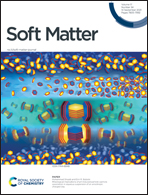Hydrodynamics of immiscible binary fluids with viscosity contrast: a multiparticle collision dynamics approach
Abstract
We present a multiparticle collision dynamics (MPC) implementation of layered immiscible fluids A and B of different shear viscosities separated by planar interfaces. The simulated flow profile for imposed steady shear motion and the time-dependent shear stress functions are in excellent agreement with our continuum hydrodynamics results for the composite fluid. The wave-vector dependent transverse velocity auto-correlation functions (TVAF) in the bulk-fluid regions of the layers decay exponentially, and agree with those of single-phase isotropic MPC fluids. In addition, we determine the hydrodynamic mobilities of an embedded colloidal sphere moving steadily parallel or transverse to a fluid–fluid interface, as functions of the distance from the interface. The obtained mobilities are in good agreement with hydrodynamic force multipoles calculations, for a no-slip sphere moving under creeping flow conditions near a clean, ideally flat interface. The proposed MPC fluid-layer model can be straightforwardly implemented, and it is computationally very efficient. Yet, owing to the spatial discretization inherent to the MPC method, the model can not reproduce all hydrodynamic features of an ideally flat interface between immiscible fluids.

- This article is part of the themed collection: #RSCPoster Conference


 Please wait while we load your content...
Please wait while we load your content...